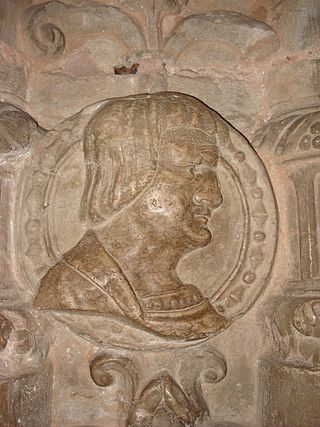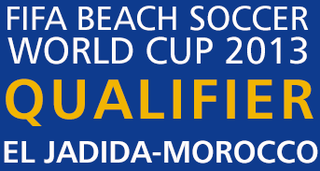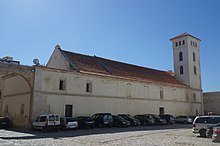
El Jadida is a major port city on the Atlantic coast of Morocco, located 96 kilometres (60 mi) south of the city of Casablanca, in the province of El Jadida and the region of Casablanca-Settat. It has a population of 170,956 as of 2023.
Sidi Mohammed ben Abdallahal-Khatib, known as Mohammed III, born in 1710 in Fes and died on 9 April 1790 in Meknes, was the Sultan of Morocco from 1757 to 1790 as a member of the 'Alawi dynasty. He was the governor of Marrakesh around 1750. He was also briefly sultan in 1748. He rebuilt many cities after the earthquake of 1755, including Mogador, Casablanca, and Rabat, and Abdallah Laroui described him as "the architect of modern Morocco." He also defeated the French in the Larache expedition in 1765 and expelled the Portuguese from Mazagan (al-Jadīda) in 1769. He is notable for having been the leader of one of the first nations to recognize American independence in his alliance with Luis de Unzaga 'le Conciliateur' through correspondence and Unzaga's secret intelligence service and led by his brothers-in-law Antonio and Matías de Gálvez from the Canary Islands. He was the son of Mawlay Abdallah bin Ismail and his wife a lady of the Chéraga guich tribe.

Mudéjar art, or Mudéjar style, was a type of ornamentation and decoration used in the Iberian Christian kingdoms, primarily between the 13th and 16th centuries. It was applied to Romanesque, Gothic and Renaissance architectural styles as constructive, ornamental and decorative motifs derived from those that had been brought to or developed in Al-Andalus. These motifs and techniques were also present in the art and crafts, especially Hispano-Moresque lustreware that was once widely exported across Europe from southern and eastern Spain at the time.

The Convent of Christ is a former Catholic convent in Tomar, Portugal. Originally a 12th-century Templar stronghold, when the order was dissolved in the 14th century the Portuguese branch was turned into the Knights of the Order of Christ, that later supported Portugal's maritime discoveries of the 15th century. The convent and castle complex are a historic and cultural monument and was listed as a UNESCO World Heritage site in 1983.

The Cathedral of Évora is a Roman Catholic church in the city of Évora, Portugal. It is one of the oldest and most important local monuments, lying on the highest spot of the city. It is part of the historical city centre, and the seat of the Archdiocese of Evora.

The Alcobaça Monastery or Alcobasa Monastery is a Catholic monastic complex located in the town of Alcobaça, in central Portugal, 120 km (75 mi) north of Lisbon and 110 km (68 mi) south of Coimbra.

Tourism in Morocco is well developed, maintaining a strong tourist industry focused on the country's coast, culture, and history. The Moroccan government created a Ministry of Tourism in 1985. Tourism is considered one of the main foreign exchange sources in Morocco and since 2013 it had the highest number of arrivals out of the countries in Africa. In 2018, 12.3 million tourists were reported to have visited Morocco.
The style of Portuguese sovereign has varied over the years. Currently, there is no Portuguese monarch but there is a pretender: Duarte Pio, Duke of Braganza. He styles himself following some of the ancient traditions of the Portuguese monarchy.

Moroccan–Portuguese conflicts refer to a series of battles between Morocco and Portugal throughout history including Battle of Tangier, Fall of Agadir and other battles and sieges in the Moroccan coast.

João de Castilho (1470–1552), also known as Juan de Castillo, was a Castilian and a notable Iberian architect born in Castillo Siete Villas, actually Arnuero (Cantabria). He is recognisably one of the premier architects in Portuguese history, responsible for several World Heritage buildings. He was a Spanish-Portuguese master builder and architect originally from Cantabria, who developed his mature career in Portugal, where he settled in c.1508. He is considered the greatest Portuguese architect of the 16th century and one of the greatest in Renaissance Europe.

The 2013 CAF Beach Soccer Championship took place from 22 May to 26 May 2013, in El Jadida, Morocco, for the first time. It is the second time in Morocco, following Casablanca hosting the previous qualification tournament in 2011. It was originally scheduled for 10–14 April and then for 29 May - 2 June 2013. The two finalists of the championship qualified for the 2013 World Cup and went on to represent Africa in Tahiti in September.

Churches and Convents of Goa is the name given by UNESCO to a set of religious monuments located in Goa Velha, in the state of Goa, India, which were declared a World Heritage Site in 1986.

The Church of Our Lady of the Rosary is a Catholic church built between 1544 and 1547, in Old Goa, State of Goa, India. This church is part of the collection belonging to the World Heritage Site of churches and convents of Goa.

The Portuguese Cistern is a historic cistern in El Jadida, Morocco. It is located beneath the citadel at the heart of the historic Portuguese fortified city of Mazagan. It is a classified cultural heritage monument in Morocco and, along with the rest of the old walled city, forms part of a UNESCO World Heritage Site.
The Fort São Marçal also known as Sena Fort is a former fort of the Portuguese Empire built in Vila de Sena, Caia District in Mozambique.

The Siege of Mazagan of 1562, also known as the Great Siege of Mazagan was an armed engagement that took place in the modern city of El Jadida, then known as Mazagan, between Portuguese forces and those of the Saadi dynasty, which had unified Morocco a few years prior.

The siege of Mazagan of 1769 was the last engagement between Morocco and the Portuguese in Mazagan. The Moroccan army under Sultan Mohammed ben Abdallah was victorious and the Portuguese evacuated their last garrison in Morocco, bringing an end to their 354-year-long conflict.














